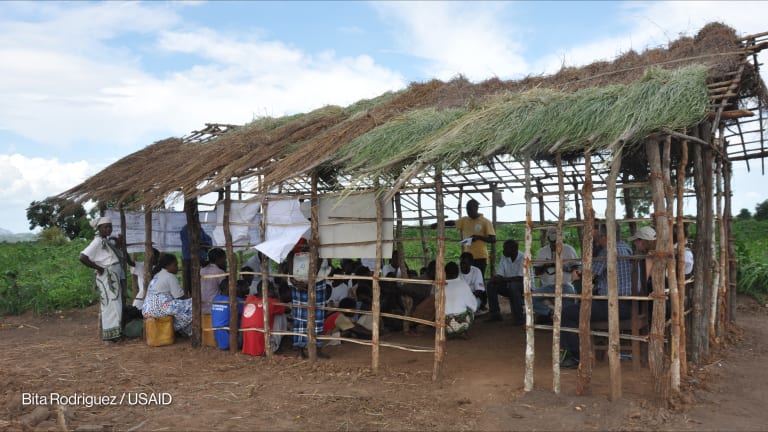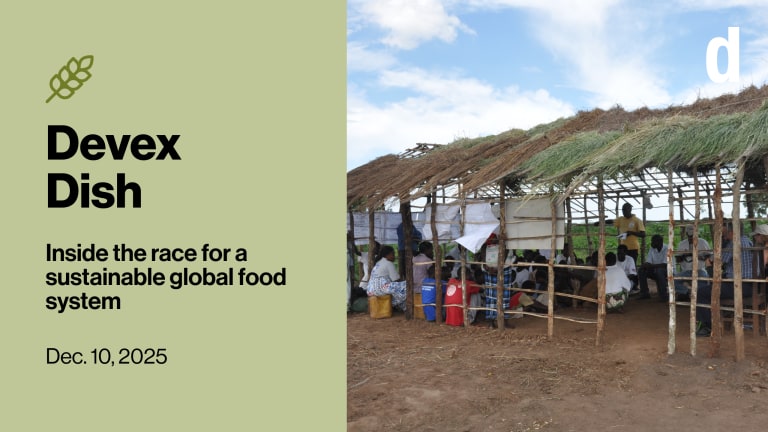
Three years of drought and the COVID-19 pandemic have left 1.35 million people in southern Madagascar in urgent need of food aid. The World Food Programme has raised the alarm over the gravity of the situation, predicting that widespread food insecurity is unlikely to improve even after the next harvest.
“In the south, the desert has been gaining over the agricultural land over the years.”
— Jean-Luc Siblot, Madagascar director, WFPThe situation has forced many people in the country to eat bugs for survival and sell off assets, such as livestock. At the epicenter of the crisis, 3 out of 4 children have dropped out of school to help their families search for food. A situation report from WFP shows that about 11% of children under 5 in the three most impacted areas suffer from global acute malnutrition — a measure that signifies an increase in risk of illness and death from lack of food. Local authorities have also reported deaths from starvation, according to WFP.
WFP’s field workers have said that people in the region are comparing what is happening to the 1992 famine in the southern part of the country, the worst food insecurity experienced in the country in recent decades.
Last year, the harvest was extremely weak compared to previous years, leaving 554,000 people in urgent need of food aid. But this coming harvest is expected to be worse, Jean-Luc Siblot, Madagascar director at WFP, told Devex. Funding shortfalls and challenges with food distribution have also limited the organization's ability to supply food to all the people in need.
“We are facing a very critical situation right now,” he said.
Poor harvest, weak rains, and intense sandstorms
The majority of people in the southern part of the country are farmers or cattle herders already living on the edge of food insecurity, Siblot said. Almost 80% of the population relies on subsistence agriculture.
People typically plant crops in November, December, and January — the main rainy season — reaping the rewards of that harvest during April, May, and June.
UN food systems envoy warns of double threat to food security in Africa next year
Widespread drought expected to hit the African continent next year will likely multiply the existing food insecurity caused by COVID-19, Agnes Kalibata, president of the Alliance for a Green Revolution in Africa, tells Devex.
But the harvest is not expected to provide much relief this year because there has been very little rain in the southern part of the country. This was compounded recently by unusually intense and frequent sandstorms that began at the end of November which dried out and covered recently planted crops with sand.
The southern part of the country is starting to resemble the Sahara Desert, Siblot said, with climate change expected to lessen rainfall and make it more erratic moving forward. Over the past five years, four out of five growing seasons were affected by drought and this current lean season, which is the period just before the harvest, is the most severe in the past decade, according to WFP.
“In the south, the desert has been gaining over the agricultural land over the years,” Siblot said.
In the past, a saving grace for farmers has been their ability to venture into urban areas to pick up small jobs to survive between harvests. But the pandemic brought recession in the country, hitting industries including the textile sector, mining, and tourism.
About 65% of households reported a loss of revenue during the crisis and the lockdowns pushed another 1.38 million people into extreme poverty. Farmers from the south were either not able to move around, because of restrictions, and if they were able to move around, they couldn’t find jobs because the informal sector in urban areas was hit particularly hard.
“They do not have the cash that will help them to the next harvest,” he said.
Distribution challenges and funding shortfalls
WFP is currently providing food aid, as well as cash transfers in places where markets are functioning.
But to get food to people in southern Madagascar is a challenge. The roads don’t have tarmac and recently a main bridge collapsed. The alternative route only allows for trucks to carry 20,000 pounds (9,072 kilograms) of food at a time, making food delivery slow and expensive.
“The logistical problem is a nightmare,” Siblot said.
While the organization aims to reach 891,000 people with emergency food distribution through June, funding restraints mean the agency expects to reach about 660,000 people through the end of April, which is less than half of the total number of people in need of aid.
As a result, the organization is calling for $34.7 million for the next six months to reach the full 891,000 for food distributions and malnutrition treatment. WFP headquarters has provided an advance loan of $10 million, to help sustain minimum levels of distribution, which ultimately needs to be repaid with donor funds. According to unofficial figures provided by Siblot in recent weeks, WFP Madagascar has secured about $2.5 million from donors, leaving a funding gap of $32.2 million.
There are a few other organizations working in the food aid sector, mainly Catholic Relief Services and Adventist Development and Relief Agency International, but not enough to cover the basic needs of the population, Siblot said.
“We have the feeling that, unfortunately, the situation will continue to worsen especially because we don't have all the cards in hand to feed in an emergency situation all the people in need,” he said.








